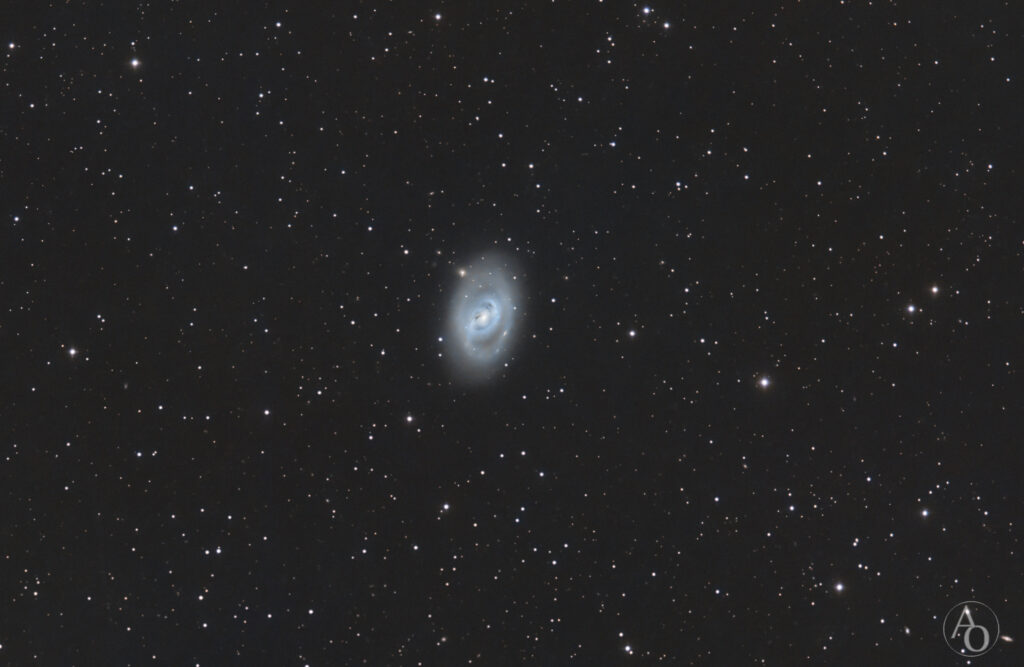Messier 96 (also known as NGC 3368) is a barred spiral galaxy 34 million light years away in the constellation Leo. It was discovered by Pierre Méchain in 1781.
It is the brightest member of the M96 Galaxy Group and also includes galaxies M95, NGC 3384 and M105, as well as a large group of fainter galaxies.

Like other barred spiral galaxies, M96 also has a bar inside the main one and smaller than it, as well as an inner disk of stars and there is a certain amount of molecular hydrogen in its central region. It also has a pseudobulb and a supermassive black hole at its center of 7.5 million solar masses.
The reason for the asymmetry of M96 is unclear; It could be the result of gravitational interactions with other galaxies in the Leo I group, but the lack of diffuse glow in the interior of the group indicates few recent interactions.
On May 9, 1998, a bright supernova, SN 1998bu, of magnitude 13, was discovered, rapidly increasing in brightness to 11.8. In 1999, Saurabh W. Jha (et al.) observed such an event and reported the following in their study:
“We present optical and near-infrared photometry and spectroscopy of type Ia SN 1998bu in the galaxy M96 (NGC 3368) of the Leo Group I. The data set consists of 356 photometric measurements and 29 spectra of SN 1998bu between May 11, 1998 and July 15, UT. The well-sampled light curve indicates that the supernova reached maximum light at B on UT 19.3 May 1998 (JD 2450952.8 +/- 0.8) with B = 12.22 +/- 0.03 and V = 11.88 +/- 0.02.»
«Application of a revised version of the Multicolor Light Curve Shape (MLCS) method produces an extinction towards the supernova of A_V = 0.94 +/- 0.15 mag, and indicates that the supernova had an average luminosity compared to other supernovae normal type Ia. says S. Jha (et al). “Using the HST Cepheid distance modulus to M96 (Tanvir et al. 1995) and the MLCS fitting parameters for the supernova, we derive an extinction-corrected absolute magnitude for SN 1998bu at most, M_V = -19.42 +/- 0.22. »
“Our independent results for this supernova are consistent with those of Suntzeff et al. (1999). Combining SN 1998bu with three other well-observed local gauges and 42 supernovae in the Hubble flux produces a Hubble constant, H_0 = 64^{+8}_{-6} km/s/Mpc, where the error estimate incorporates possible sources of systematic uncertainty including the calibration of the Cepheid period-luminosity relationship, the metallicity dependence of the Cepheid distance scale, and the distance to the LMC.”
Technical data of the acquisition:
Baader Blue (CMOS-Optimized) 36 mm: 20×300,″(1h 40′)
Baader Green (CMOS-Optimized) 36 mm: 20×300,″(1h 40′)
Baader Red (CMOS-Optimized) 36 mm: 20×300,″(1h 40′)
Baader UV/IR CUT Luminance (CMOS Optimized) 36 mm: 25×300,″(2h 5′)
Time integration:
7h 5′
As Kim Pederson (Danish Institute for Space Sciences, University of Copenhagen) said in a 2000 study:
“The nearby sparse group of galaxies (D = 11 Mpc), Leo-I, is unique in many ways. It is the closest group containing bright spirals (M96 and M95) and a bright elliptical (M105). A giant intergalactic ring Hi (diameter ca. 200 kpc) orbits the central galaxy pair M105/NGC3384 and appears to interact with M96. “If M96 is indeed at the core of the cluster, the Leo-I cluster provides an unusually ‘clean’ path to determining the Hubble constant.”
“In our 22 ksec ASCA SIS exposure of M96, we have detected diffuse X-ray emission extending more than 10 arcminutes north of M96, in the direction of the Hi ring. The morphology and spectral characteristics of the diffuse emission show that M96 recently interacted with the Hi ring, indicating that M96, the Hi ring, and the central galaxy M105 are the same distance within a few percent.”

